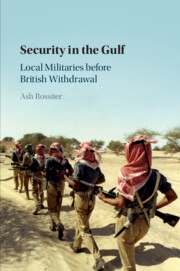Book contents
- Security in the Gulf
- Security in the Gulf
- Copyright page
- Contents
- Preface
- Abbreviations
- Introduction
- 1 Patterns of Protection in the Gulf
- 2 British India and Local Security Arrangements
- 3 Local Militaries and Intensified British Interests
- 4 Intervention or Local Means of Coercion?
- 5 Local Forces and Britain’s Silver Age in the Gulf
- 6 Securing the Gulf after Britain’s Withdrawal
- Conclusion
- References
- Index
5 - Local Forces and Britain’s Silver Age in the Gulf
Published online by Cambridge University Press: 15 June 2020
- Security in the Gulf
- Security in the Gulf
- Copyright page
- Contents
- Preface
- Abbreviations
- Introduction
- 1 Patterns of Protection in the Gulf
- 2 British India and Local Security Arrangements
- 3 Local Militaries and Intensified British Interests
- 4 Intervention or Local Means of Coercion?
- 5 Local Forces and Britain’s Silver Age in the Gulf
- 6 Securing the Gulf after Britain’s Withdrawal
- Conclusion
- References
- Index
Summary
When money-sensitive civil servants questioned British expenditure on local forces, supporters of this spending argued that it was less costly in the long run as greater indigenous capabilities would reduce the likelihood of Britain having to intervene directly and could reduce defence expenditure in the long term. This was the logic applied in Kuwait after independence from Britain in 1961. This was especially true after 1966 when Britain reduced its defence commitment to Kuwait air support only. Unlike Kuwait, the build-up of military capabilities in the Trucial States and Bahrain was not seen as a security gain for Britain. Accepting its reduced ability to shape events in the Gulf, however, Britain reasoned that if it could not stop the rulers from setting up their own armed forces – or prevent them from expanding too rapidly – then it might as well try to steer them in the right direction. The right direction for Britain meant, if possible, that British officers (contract or loan service) should command and train these forces and that they should use weaponry produced by British manufacturers.
Keywords
- Type
- Chapter
- Information
- Security in the GulfLocal Militaries before British Withdrawal, pp. 149 - 208Publisher: Cambridge University PressPrint publication year: 2020



